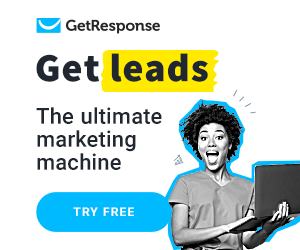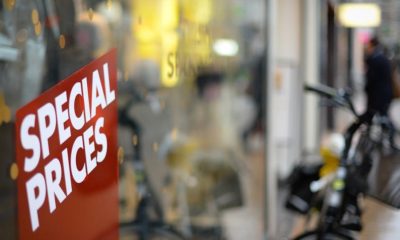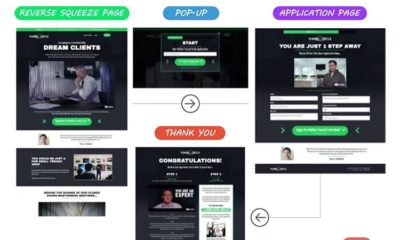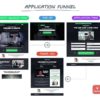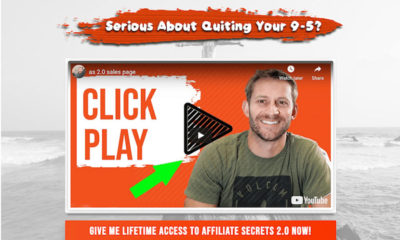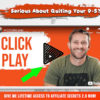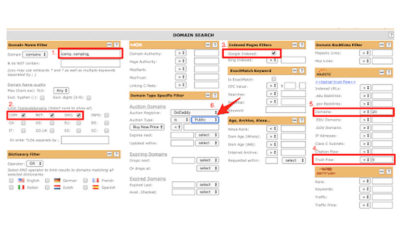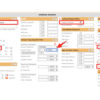Uncategorized
The Beginner’s Guide to Paid Media Ecommerce Advertising
Did you know that global retail eCommerce sales surpassed $4.9 trillion in 2021? And it’s expected that this figure will grow by approximately 50% by 2025.

Growth in the eCommerce business has resulted in more competition and necessitated a shift in ecommerce marketing tactics, especially as more people become accustomed to buying online. Online eCommerce advertising is one approach that many businesses have found to be very successful. You can reach a larger audience, raise brand recognition, and increase sales with an effective advertising strategy. But, how exactly do you build an effective eCommerce advertising strategy? That’s what we are going to discuss in today’s article.
What is eCommerce advertising?
Ecommerce marketing is the use of sponsored messages through various media to raise brand awareness and promote eCommerce items. Paid messaging may be delivered both offline and online. In this post, we’ll solely focus on online advertising techniques, so we’ll look at Google, Facebook, and TikTok’s digital advertising platforms.
Ecommerce marketing is the practice of promoting an online store in order to raise customer awareness, generate leads, and boost sales. Even digital marketing methods such as search engine optimization (SEO), which focus on attracting organic traffic, are part of eCommerce marketing.
Speaking of other eCommerce marketing strategies…you may also want to check our essential guide to ecommerce email marketing.
You must, however, pay for impressions and clicks when you distribute advertisements to publishers with eCommerce advertising. As an example, you’ll have to pay Google for the impressions or views your eCommerce advertisements get when they appear on YouTube videos. Meanwhile, social media sites like Facebook and Instagram operate on a pay-per-click basis. You’ll pay the publisher for every click your social ads generate.
Paid ads vs organic traffic
Why spend money on advertisements instead of generating natural traffic to your eCommerce website? What if you’ve already got a high ranking in search engines? Is it still worthwhile to utilize paid marketing in today’s digital environment? Unfortunately, organic traffic and excellent rankings are no longer enough in today’s digital marketplace. I’ll show you how it’s done.
Let’s use Macy’s and Nordstrom as examples. These are well-known online retailers with strong SEO. As a result, when you search for phrases like “women’s heels,” you would expect the shops to perform well in those categories. And they usually do.
But here is the thing, before you can get to the organic results, you will see a Google ads carousel at the top.

This means prospective buyers will interact with the ads first before seeing the organic results. Depending on how optimized these ads are, most potential buyers may never scroll down enough to see the organic results.
That’s one major reason not to rely on organic traffic alone, regardless of how strong your SEO may be. But it’s not the only takeaway from this scenario. The image above shows that ads can help smaller online stores get the upper hand over more established brands. Wouldn’t you want that advantage for your store?
Paid ads vs organic social media
On social media, things are even worse. Organic reach has decreased on platforms like Facebook, according to ecommerce marketers. Facebook even admitted that organic reach was dropping and gave two reasons for it. One of those reasons is that more material is being created and there isn’t enough newsfeed space to display it all.
So, you may have the best-in-class social media marketing strategy, but it still won’t be enough since these platforms don’t have enough space to handle everyone’s content. Put simply, your ecommerce business has little choice but to run social media ads.
Perhaps the biggest reason why ecommerce advertising is essential is that social media and Google ads support remarketing. Let’s face it, the majority of first-time website visitors are never ready to buy. A 2017 report by Episerver actually reported that 92% of first-time visitors abandon sites without making a purchase.
One clever way to get these people back to your store is through retargeting ads. With this strategy, you can target previous site visitors with personalized ads showing the exact or similar products they looked at when on your site.
Retargeting advertising are a great approach to get these individuals back to your store. With this method, you may target previous site visitors with personalized advertisements that display the items they looked at while on your website.
This is one area where the GetResponse online ad creator (that’s our product) comes in handy. Using our tool, you may create retargeting advertising promoting relevant and personalized offers to those who have expressed interest. All you have to do is install the Facebook Pixel on your eCommerce site’s landing pages to monitor site traffic. Then, use our Facebook and Instagram ad creator to make and launch your remarketing ads.

Before you invest in eCommerce advertising
Here are some tips to keep in mind before putting your money on paid advertising:
1. Know your target audience
Knowing your target audience makes creating a solid eCommerce advertising strategy easier. First, you will know which channels your potential customers use. That will help you focus your efforts and resources on a platform that will generate meaningful ROI.
Understanding your target audience will also inform your brand messaging. You can use appropriate language to appeal to teens on TikTok if they are your target audience, for example.
How do you know your target audience? Simple. Go through your customer database. Speak to them directly, send them a survey via email, or observe them on social media.
2. Understand prospects will be at different stages of the buyer’s journey

Not every potential customer will be ready to buy when they interact with your paid ads for the first time. Some don’t even know they need your products. Worse still, some prospects may not know about your existence.
Therefore, your paid advertising strategy should cater to all prospects at different stages of the buyer’s journey. You’ll need to create ads for prospects at the top of the funnel – cold audiences who still need awareness about your brand and products.
Just as important are the people in the middle of the funnel – prospects who now know your brand and products but still require some convincing to buy.
Finally, you’ll need ads for the engaged prospects that know your brand and have visited your website and product pages. That’s where remarketing campaigns come in.
The good news that is all top channels can help you target prospects at the different stages of the marketing funnel.
That brings us to the next subject – what are the best types of online advertising for eCommerce businesses?
Types of online advertising for ecommerce and how to use them effectively
There are dozens of digital marketing channels, but they don’t all perform the same. Some are better than others helping businesses generate a more significant ROI. So, here are the top online ecommerce advertising channels that can help you achieve your marketing goals:
Search ads
Search ads are some of the most effective ecommerce ads you could use. As I demonstrated above, these ads can help you “outrank” bigger ecommerce businesses in the search engine results pages. Not only that, but they are also very effective at targeting users with higher buyer intent. But, of course, it all depends on how robust your Google Ad campaign strategy is.
Search ads are usually displayed at the top of organic search results. They are also formatted like typical search results but with an “Ad” tag.

These ads can drive more qualified traffic to your ecommerce store. Targeting keywords with higher buyer intent can also increase your sales significantly.
Nailing your target keywords is only the first step, though. You must also write a compelling search ad copy that captures users’ attention for optimal engagements and click-through rate (CTR). Here are some tips on how to write such a copy.
Target the right keywords

Do comprehensive keyword research before writing your ad copy. That research should help you identify keywords your target audience would use in their search queries.
Put yourself in your target customer’s shoes and think about the words you would use to search for products. Another ingenious strategy is to spy on your competitors. Check out their Google ads keeping an eye on the keywords used.
Once you have a decent keyword list, write your ad copy, including the relevant keywords at strategic places, i.e., in the headline, description, and URL.
Also, don’t forget about writing down keywords you don’t want your ads to appear on and adding them to the “negative keywords” list. The more keywords you add there, the more targeted your campaign will be.
Include a clear call to action
Make sure the ad copy tells interested buyers what they need to do next. Whether it’s purchasing a product or signing up for something, the CTA should be crystal clear and unmissable.
CTA is also one of the few elements you’ll need to A/B test. For example, you can create one ad copy with two CTA variations to identify the most effective call to action for your target customers.
Utilize ad extensions
Ad extensions enrich your search ad copy with additional data. One such extension is Google’s Sitelink extension. This allows you to add links to several target pages in your Google ads.

Use this extension to help users find the exact product or page they want. You can also use it to maximize CTR by offering additional pages of interest, as captured in the Berrylook ad above.
Another one is the Lead form extension that lets you collect the contact details of your prospects directly from their browser. Think of them as Facebook Lead Ads but on Google.
You’ll find more tips on writing effective search ads in our article How to Create Google Ads in GetResponse.
Optimize your landing page

Too many marketers make the mistake of focusing on ads and not the landing page. In fact, some business owners link their ads to the homepage or product pages instead of specific landing pages. That’s a huge mistake.
After creating a killer product ad, ensure the target link goes to that particular product page. Next, ensure the landing page is optimized for conversions. You can use the GetResponse landing page builder for this purpose. There are dozens of mobile-friendly landing page templates to get you started. You can also customize the landing pages conveniently with the drag-and-drop tool.

One of the things you need to consider when building your landing pages is the brand message. Make sure the brand message and value proposition are consistent with what is included in the ad.
Social proof is also critical. Add reviews, testimonials, or ratings, then include a strong CTA on the landing page. Check out this guide for more tips on optimizing your ecommerce landing page for high conversions.
Remember that landing page optimization applies to all types of paid eCommerce advertising, not just search ads.
Display ads
Unlike search ads that appear on the SERPs, display ads are shown on web pages of other websites. They can be displayed as banner ads or on the sidebar, for example.

Google display ads can also appear on YouTube.

Your ecommerce business can get more exposure by targeting audiences of other brands with strategic ad placements. Display ads can also increase your inbound traffic and sales, especially if you get your targeting parameters spot on. Plus, you can use these ads for remarketing campaigns.
Below are some display ad tips to guide you:
Define your target audience
Identify your target audience, then set the necessary parameters to ensure your ads are shown to qualified leads. And don’t use demographic data alone for audience targeting. That’s too basic and broad. Instead, use additional data points like interests and behaviors to narrow down your target audience for better results.
Create and target a custom audience
One easy way to optimize CTR and conversions is to identify custom audiences and target them with suitable ads. For example, you can create a custom audience consisting of prospects who visited a competitor’s site. Then, target them with your optimized display ads. These prospects are likely to engage with your ads since they’ve already shown interest by visiting a competitor’s store.
Exclude irrelevant ad placement
Google allows you to see the websites showing your display ads. You can access that data from “Placements” under “Display Campaigns” in the Merchant Center.
Go through the list and ensure your ads are shown to qualified audiences. You can even sort through the placements by impressions and clicks. Check the placements generating the most clicks and ask yourself whether the site is relevant for your target audience. Doing this can help optimize your ad spend.
I should point out that search adverts have better conversion rates than display ads. Nevertheless, display ads can be resourceful for smaller businesses since they are cheaper.
Google Shopping Ads
Google shopping ads are ideal when your primary objective is to increase sales. The ads feature an image, price, product rating, and link to the store. These ads are triggered when a user searches for specific keywords.
For example, if you search “shop cargo pants,” the following shopping ads appear above organic search results.

Optimizing Google shopping ads is slightly different from other types of ads. For example, shopping ads don’t allow you to add target keywords like you usually do with search or text ads. But there’s still a way to ensure your ads show up to the right people. Here are three vital tips on how to optimize your shopping ads.
Optimize product feeds
Google extracts the data from your product feeds and uses it to place your ads under relevant search queries. That makes product feed optimization super important.
Go to your Merchant Center and ensure everything from product titles and images to prices is optimized correctly. For example, use the right target keyword towards the beginning of product titles. You should also ensure the data on pricing is updated and shown in the correct currency.
Use high-resolution images
Images are critical in google shopping ads. A good image captures shoppers’ attention and could be enough to increase your click-through rate. That’s why it’s imperative to use high-quality images for all products. Also, use original images that match the actual product – not placeholder or highly-edited images that may dupe interested buyers.
Add negative keywords
Unlike text ads, there’s no way to add specific target keywords when creating shopping ads. What you can do instead is optimize your product data feeds. Still, Google allows you to create a list of negative keywords (also available in search ads) to optimize your campaign. Use this feature to stop your dynamic product ads from appearing under irrelevant or unprofitable search queries.
For example, it won’t make sense for your ads to appear under “children’s/toddler apparel” search queries if you only sell adult apparel. Similarly, you should stop your ads from being triggered by broad and generic queries that could hurt your shopping ads quality score.
Facebook ads
With over 2.91 billion active monthly users, Facebook advertising is a no-brainer for any ecommerce store that wants to reach more people. But, if that’s not a good enough incentive, consider this; Facebook ads have an average conversion rate of 9.21 percent, according to WordStream. For some perspective, the average conversion rate of Google search ads is 3.75 percent.
Of course, the conversion rates vary from one industry to another. Still, these figures show just how critical it is to run Facebook ads.
Another good thing with Facebook advertising for eCommerce businesses is the different ad formats marketers get to play with. First, you have Facebook story ads. These appear between users’ stories. They are ideal for both building brand awareness and driving more sales.
Next, we have Facebook photo ads that appear on the newsfeed. This is the perfect ad format to showcase your product in crisp images. You can also show your products in action by capturing images of other people using the items. This can trigger an emotional response from viewers, resulting in higher engagement rates.
Check this out:

Tieks by Gavrieli is an eCommerce store selling designer flats. In the above ad, the company has utilized carousel ads (more on this later) really well. They show interested buyers how they could look wearing their flats with different outfits.
They’ve also used models of different skin complexions to ensure everyone can imagine themselves wearing the flats. It’s a simple but effective strategy. Some companies even utilize user-generated content from existing customers for an even bigger impact.
The Facebook video ad is another impressive format. These ads can outperform static photo ads in various scenarios. For example, we can all agree that some products are better showcased with videos, not static images. Also, videos give you a bigger window to engage potential customers.
For example, Whole Foods Market, which offers both in-store and online shopping experiences, added influencer marketing into their eCommerce advertising strategy in one of their ads. They partnered with makeup artist Jamie Greenberg who went around the store shopping for her favorite products.

You can use a similar approach in your video ads. You can provide a quick tutorial on how to use your product, for example.
Ultimately, the engagement and click-through rate of video ads will depend on the quality of your ads. Follow these video marketing best practices to get the best results from your Facebook video ad campaigns:
- Create shorter ads
- Capture the viewer’s attention as early as possible
- Optimize ad description and title
- Upload high-res videos
- Use the correct aspect ratio for your videos. Facebook recommends 1:1 square videos or 16:9, 9:16, and 4:5 vertical aspect ratios.
- Don’t forget to include a powerful CTA.
Facebook carousel is the other interesting ad type. With this format, you can add multiple images to form a carousel. Interested buyers can then scroll through the carousel, viewing different products from one ad unit.

The Facebook carousel ad format is very effective at highlighting the different features of a single product. And if you want to increase engagements even further, create a panoramic image and split it into several parts to form your carousel. This triggers people’s curiosity pushing them to swipe through the carousel.

Moreover, you can use the Facebook carousel ads to tell your brand story and show how your products work.
Finally, we have the Facebook collection and instant experience ads. These two ad formats work in tandem to improve the user experience and hopefully speed up the conversion process.
With Facebook collection ads, you get to create a primary image or video and then add three smaller images at the bottom, forming a grid-like layout.

Facebook instant experience ads, on the other hand, combine multiple ad formats to deliver an “instant experience” of your brand or products. For example, a potential buyer can watch a product video and scroll through multiple product images by clicking a single instant experience ad.
Facebook instant experience is very effective for eCommerce stores when used correctly. For example, the popular online beauty store Sephora utilized Facebook collection and video ads to create an instant experience in one of their campaigns. The results were nothing short of incredible. Their CTR increased by a whopping 41 percent compared to their previous digital campaigns. Their reach also increased by 30%, while the return on ad spends went up by 32%.
Clearly, your online store can benefit hugely from the different ads available on Facebook. And the GetResponse online ad creator will help you make impressive Facebook ads optimized for conversions. The tool also creates Instagram ads, the final form of e-commerce paid ads you should use.
Instagram ads
Instagram has about 1.22 billion monthly users. The platform also ran a survey and discovered that 44 percent of people use the shop tab and shopping tags to shop from Instagram every week. This is a platform you don’t want to sleep on. Plus, you don’t need the largest marketing budget to utilize this channel. It’s very possible to run successful Instagram ads on a budget.
Instagram has similar ad formats as Facebook. You have Instagram story ads, photo ads, video ads, collection ads, and carousel ads. The tactics for using these ad formats are pretty similar to what we’ve discussed above.
In addition to the five Instagram advert formats, the social media platform has two other unique ad formats that can drive your ecommerce sales. Well, technically it’s three if we considered Reels. However, Reels is Instagram’s answer to TikTok. The tab features short-form videos. So, you’ll need to create short catchy video ads for this section.

Otherwise, here are the two ad formats unique to Instagram:
Explore Ads
Explore ads are very similar to the ads shown in the main feed. The difference is these ads appear in the explore tab. However, they don’t show up as one of the many photos and videos in the explore feed. Instead, they appear when a user clicks on a specific photo or video in the feed and starts scrolling.
For example, based on my activities in the app, I receive fitness-related Instagram ads when browsing through the explore tab.

This ad format can put your brand and products on the screens of social media users who are exploring new topics, brands, accounts, etc. They’re hence ideal not just for boosting traffic and generating leads but also for building brand awareness.
Shop Ads
Instagram shop ads are integrated into the app’s shop tag. These ads are very effective since they help you reach engaged customers who are already shopping online.

Instagram shop ads also allow users to save products on a wishlist or browse through other products from the advertising brand. Users can also share products discovered from the shop tab with their friends.
TikTok Ads
TikTok entered the western market a few years ago, but it sure has made its mark! Today, the platform has over 1 billion active users. But that’s not even the most interesting part. A few months ago, you would have been excused for thinking TikTok is only a Gen Z sensation. That’s not the case anymore. Get this; more than 60 percent of TikTok users in the US are above 20 years old.

Therefore, TikTok is not just a great eCommerce advertising platform because it has insane numbers. It’s also not a great advertising platform for Gen Zs alone. This popular social media platform can generate incredible results even for brands targeting millennials and older generations.
But, of course, you’ll need to check the statistics in your specific region to get an idea of how successful a TikTok advertising strategy may be for you.
That said, here are the types of TikTok ads you could use for your eCommerce advertising campaigns:
Infeed ads
Infeed ads appear on TikTok’s “For You Page.” That means viewers will come across your videos while scrolling through their timelines. This is good, but it also comes with unique challenges. It’s good in that your target audience will naturally come across the ad while experiencing the addictive app.
On the flip side, infeed ads are pretty easy to skip. Therefore, you’ll have to get creative to stop users from scrolling past your ads.
You’ll need to follow most of the other social media video advertising best practices. First, make sure your videos are short and engaging. Second, ensure the first 3 to 5 seconds are catchy. This is your opportunity to grab viewers’ attention.
Finally, make sure the ad has a crystal clear call to action.
Besides, videos, you can also create spark ads as infeed adverts. This is where you will promote organic posts and have them displayed in the feed.
Brand takeover
TikTok brand takeover ads appear as soon as a user opens the app. The ad takes up the entire screen for a few seconds ensuring users can view and interact with your ad. These ads can also be shown on the For You Page, where they’ll appear as videos or still images.
Brand takeover ads are unmissable. That makes them an excellent choice for any brand looking to build awareness or generate more sales. The drawback is they are pretty expensive.
TopView
TopView ads are almost similar to brand takeover ads. However, they do not appear instantly. TopView ads show up as the first infeed video three seconds after signing in.
A TopView ad can be up to 60 seconds long. They also occupy the entire screen and allow you to add a link to your landing page.
Branded effects
Branded effects are a great ad format when you want to build brand awareness and have fun with your audience. This ad format allows you to create an effect and make it usable to your audience.
Of course, you should make a creative effect that’s fun and helps showcase your brand. You should also couple it with a hashtag challenge. That’s what Colgate did with this branded effect campaign.

Note that branded effects last for only ten days.
Branded hashtag challenge
This ad format works like a regular hashtag challenge. You create a challenge, then ask users to do something, and include the hashtag in the description. However, unlike a standard hashtag challenge, this ad format puts your videos at the top of TikTok’s discover page.
Moreover, when users click on the hashtag, they’re taken to a landing page. There, they will see the brand behind the hashtag and other videos. There’s also a CTA there to direct users to your website.
The “wet n wild” case study shows the power of this ad format. Here’s a snapshot of the results they witnessed.

You can use Branded hashtag challenges to increase awareness about a new product. They are also great for boosting overall brand awareness and engagement.
Like Facebook and Google, TikTok also allows marketers to create targeted campaigns. You can target your audience by interest, location, behavior, etc. There’s also a retargeting option.
Time to level up your eCommerce marketing strategy
Organic traffic can only get you so far. If you truly want to build a successful eCommerce business, you’ll want to add paid advertising to your eCommerce marketing strategy.
In this guide, you learned all the major online advertising options available to your online store. First, you can leverage Google ads such as display, search, and shopping ads. The second option is social media advertising. Here, you will distribute your optimized ads on social media platforms like Facebook, Instagram, and TikTok. You also learned some insightful tips and tools that can help you make the most of these ads. It’s now time to put these insights into action.
If by any chance, you’re looking for a solution that’ll help you grow your eCommerce business via emails, marketing automation, SMS, web pushes, live chats, and paid ads – go ahead and try GetResponse.
You can start completely free and access our premium features for the first 30 days. It only takes a moment to sign up and you don’t need to provide your credit card details. Sounds good?
>>>Join The One Funnel Away Challenge<<<



